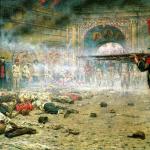Modern Russian folk orchestras for the most part have the same instrumental composition: a family of three-string domras, a family of balalaikas, button accordions, keyboards (less often ringed or plucked) gusli, and various percussion instruments. In some cases, accordions, orchestral or timbral harmonics are also introduced.
At the same time, recently, in order to enrich the timbre and expand the technical and artistic capabilities of folk orchestras, woodwind and brass instruments of the symphony orchestra - flute, oboe - are increasingly being introduced into their composition; folk wind instruments - zhaleika, bryolka, Vladimir horns, pipes, as well as piano, guitar (or electric guitar), and other instruments.
Each of the instruments of the orchestra performs one function better - melodic, bass or accompaniment. Each of the orchestra's instruments has its own distinct timbre coloring, its own technical and artistic capabilities, strengths and weaknesses. Their knowledge is necessary for the leader in the process of training orchestra players, orchestrating plays, and preparing the repertoire. This is also important in order to develop and enrich performing traditions.
Group of three-string domras.
The group of three-string domra includes four instruments: piccolo domra, small domra, alto domra, bass domra.
Domra piccolo. The instrument transposes up an octave. The range of the piccolo domra is from B of the first octave to E of the fourth octave. Instrument tuning: 1st string - A of the second octave, 2nd strings of the second octave, 3rd string - B of the first octave. The piccolo domra most often uses a high register, which sounds bright and light. The piercing sounds of the piccolo domra seem to continue upward the range of the small domra. In scores, these instruments are most often written in unison and sounded in an octave.
Basic techniques for playing the domra piccolo: tremolo, strike, pizzicato, glissando.
Domra is small. The orchestral range of the small domra is from E of the first octave to A of the third octave. Instrument tuning: 1st string - D of the second octave, 2nd string - A of the first octave, 3rd string - E of the first octave.
Small domra has an even and bright sonority throughout the entire range, with the exception of the three or four upper notes, which sound intense, with a dry metallic overtone. In the low and middle registers on the small domra, melodies of a melodious, soulful nature sound expressively. In the scores, the small domra occupies the second line after the piccolo domra.
Convenient design, small size of the small domra make it easy to play. She is the leading instrument of the orchestra. She is often entrusted with complex passages and various technical figurations.
Basic techniques for playing the small domra: tremolo, up and down strokes, pizzicato, harmonics, glissando.
Alto domra. The alto domra transposes down an octave. The range of the instrument is from E small octave to A second octave. The structure of the alto domra: 1st string - D of the first octave, 2nd string - A of the small octave, 3rd string - E of the small octave.
The alto domra has a soft, chesty sound in timbre. Only the extreme upper sounds, starting from E of the third octave, sound intense. The lower sounds, approximately from G of the first octave and below, sound somewhat muffled and indefinite in pitch. Most often, the alto domra is assigned melodic parts in the middle and lower registers or pedal accompaniment. The basic techniques of the game are the same as on the small domra.
Bass domra. The range of the instrument is from E of the major octave to F - G of the first octave. The instrument has a smooth and dense sound throughout the entire range. Build a bass domra: 1st string - D of a small octave, 2nd string - A of a large octave, 3rd string - E of a large octave. The low register gives a strong, rich, somewhat heavy sound. The middle and high registers have a soft, velvety sound.
Bass domra is most often tasked with performing harmonically consistent bass sounds. Melodies in the middle register of an octave with a double bass balalaika and an alto domra sound expressively on the bass domra. The disadvantages of the instrument are its large size, the oval shape of the body, which limits the performance of complex technical passages and requires, like an alto domra player, good physical characteristics and strong hands. Basic techniques for playing the bass domra: tremolo, percussion, pizzicato.
Thus, the sound range of the four instruments of the domra group is equal to five octaves - from E of the major octave to E of the fourth octave. Due to differences in timbre and tessitura sound, the domra group is capable of performing a wide variety of pieces. The bright, expressive color and sufficient volume of sound of the domra group rightfully make it the leading group of the folk orchestra.
Group of balalaikas.
The balalaika group includes five instruments: balalaika prima, balalaika second, balalaika alto, balalaika bass and balalaika contrabass.
Balalaika prima. The range of the prima balalaika is from E of the first octave to Re - E of the third octave. Instrument tuning: 1st string - A of the first octave, 2nd and 3rd strings - E of the first octave (in unison).
The prima balalaika has great technical capabilities. It can be used to perform complex passages, melodies of a melodious nature, and dance tunes with double and triple notes. The prima balalaika adds a unique flavor to the sound of the entire orchestra of Russian folk instruments. Along with the mala domra, it is the leading instrument in the orchestra; it is often assigned solo fragments.
Basic techniques for playing the prime balalaika: clanking, tremolo, pizzicato, vibrato, glissando.
Balalaika second. The range of the instrument is from A of the small octave to F of the second octave. Balalaika second tuning: 1st string - D of the first octave, 2nd and 3rd strings - A of the small octave (in unison).
The balalaika second is mainly assigned to the accompaniment parts. The instrument sounds best in the low and middle registers. These registers are easy to play and are where open strings are most often used. Basic playing techniques: strike, tremolo.
Balalaika alto. The alto balalaika transposes down an octave. The range of the instrument is from the small octave to the second octave. The structure of the alto balalaika is: 1st string - A of the small octave, 2nd and 3rd strings of the small octave (in unison). The alto balalaika, like the second balalaika, primarily serves as an accompaniment. The low and middle registers of the alto balalaika are the most commonly used. They are played with a finger or a soft pick. The basic techniques for playing the alto balalaika are the same as for the second balalaika.
Balalaika bass. The range and tuning of the bass balalaika are the same as the bass domra (E of the large octave - G of the first octave), but the instruments sound, due to differences in design, somewhat different in terms of timbre.
Technically, the bass balalaika is less flexible than the bass domra. Therefore, she is entrusted mainly with bass sounds, and less often with conducting melody in a low register.
Basic techniques for playing bass balalaika: kick, tremolo, pizzicato.
Balalaika double bass. Balalaika double bass transposes down an octave. The range of the instrument is from E counter octave to G small octave. The structure of the balalaika is double bass: 1st string - D major octave, 2nd string - A counteroctave, 3rd string - E counteroctave.
Due to the large size of the instrument, the sounds on the double bass balalaika are juicy, thick, and resonate for a long time. The registers of the balalaika bass and balalaika double bass are similar, so their parts are usually duplicated in an octave.
Bass and double bass are played on balalaikas most often with a leather or soft polyethylene pick.
The general range of the balalaika group is the same as that of the domra group, but shifted an octave lower (from E counter-octave to E third octave).
Bayans.
The button accordion, introduced into the Russian folk orchestra in the early 1930s, has now become one of its leading instruments. All folk orchestras include a group of button accordions varying in number. When playing in an orchestra, they most often use the right keyboard of the instrument, which has a range from G of the major octave to E of the fourth octave. Only in characteristic dance and strumming pieces, in order to give the sound greater stability and rhythm or to maintain the melodic line in the lower register, the accordion is played on the left keyboard.
The large range of the right keyboard of the instrument makes it possible to use it in pieces of different character and tessitura. The sound of this instrument goes well with the timbre of domras, balalaikas, gusli, and wind folk instruments; it brings bright, fresh color to the orchestra.
Orchestral harmonicas. In order to saturate the bass line, as well as to perform complex technical passages in a low register (it is impossible to quickly play them on the left keyboard of a button accordion), and finally, to enhance the sound of the button accordion in various registers, orchestral harmonics are introduced into some scores. The orchestral harmonica group includes six instruments - piccolo, soprano, alto, tenor, bass (baritone) and double bass.
All instruments have a right-hand keyboard only and differ from each other in size and range. Nowadays, orchestral harmonics are widely used in both string and accordion orchestras.
In their timbre, orchestral harmonics are close to the sound of ordinary button accordions, therefore, if they are present in the score and not in the club, they can be replaced with ordinary button accordions.
Timbre harmonics. Sometimes timbral harmonics are also introduced into scores. These instruments are a type of orchestral harmonica. Each of them has only a right-hand keyboard and has a special timbre, reminiscent of the sound of one or another wind instrument of a symphony orchestra. Hence the name of the instruments - flute, oboe, clarinet, bassoon, etc. Timbre harmonics do not yet have an established design and a certain range.
Variety of types of domra
The end of the 19th century is a period of revival in the history of domra. At this time, the wonderful Russian musician-researcher V.V. Andreev did the most difficult and painstaking work to restore and improve Russian folk instruments.

The reconstructed three-string domra received a fourth tuning and a full chromatic scale and was included in the ensemble of folk instruments.

It was according to the instructions of V.V. Andreev created a family of domras of different sizes - piccolo, small, viola, bass and double bass. The tenor domra is used less frequently.

At the beginning of the 20th century, G.P. Lyubimov and S.F. Burov designed a family of four-string domras of fifth scale. Since then, domra has firmly taken its place in the music world.
Domra device

Domra consists of three parts: an oval-shaped wooden hemispherical body, a neck (neck) and a head.
The body consists of: a body, a soundboard that covers the body from above and is edged along the edges with a shell, buttons for securing the strings and a bottom sill that protects the soundboard from the pressure of the stretched strings.

In the middle of the soundboard there is a round hole - a resonator with a figured rosette. Above the soundboard, near the fingerboard, there is a hinged shell that protects the soundboard from scratches when playing. A stand - an armrest - is sometimes attached above the strings and the lower sill.

A neck is inserted into the body, onto which a fingerboard with saddles and frets located between them is glued. Fret counting starts from the nut. On the headstock there are pegs that regulate the tension of the strings.
Domra is a famous plucked musical instrument, which is considered a “folk instrument” in a number of countries. , in particular in Russia, Ukraine, Belarus. It has an oval body, a short neck and 3-4 strings (quart or fifth tuning; the three-string modification is widespread only in Russia). Notes of a 3-string domra: D (second octave); A, E (first octave), and 4 strings: E (second octave); A, D (first octave); G (small octave).
Sound, as a rule, is produced using a mediator, less often with the pads of the fingers. The most characteristic technique for domra is tremolo, fast and rhythmic “rattling”, “trembling”. If we talk about relatedness, then it is closest to and. The principle of their design is similar, but there are some differences - both structural and in structure.
For a number of reasons, the domra was not used for a long time, and only at the end of the 19th century was it reconstructed and recreated on the basis of the “Vyatka balalaika”, then the concept of “orchestral domra” appeared, this type of instrument has survived to this day. Children entering a music school can choose a domra class and practice on this instrument: it is light, relatively inexpensive, can be taken home, and will not disturb the neighbors; For these reasons, many parents send their young musicians to study this particular musical instrument.
Brief history of origin
The origin of the word “domra” is very simple: in Turkic “dumbra” is a balalaika, but these instruments are very similar in design and sound. Initially, they were played by buffoons (free jesters), around the 16th-17th centuries, ensembles consisted of several musicians, which often included bagpipes, tambourines, etc. It is interesting that earlier the emphasis was placed on the last syllable, resulting in “domra?” The instrument was not only ensemble, but also solo, which indicates high practicality and applicability.
The persecution of buffoons began in the 17th century, when they began to be imprisoned or executed for bold jokes on the boyars and clergy. Along with the class of free jesters, their instruments were also exterminated, since they began to be perceived by the people as something seditious, dangerous, forbidden; no one wanted to keep a domra at home. At the same time, the harp existed perfectly at all times and was not affected by any reprisals or reprisals. Domra mysteriously disappeared completely and remained only in popular prints and frescoes. The instrument acquired its modern appearance only in the 20th century, this was mentioned above
What does domra consist of?
Like many plucked string instruments, the domra consists of a body and a neck, a hole is made in the body for sound to enter, and on the neck there are frets; the strings are tensioned using a pegs system that uses a “worm gear”. The body has two main structural parts - the body (lower bowl-shaped part) and the deck (upper part). Elements are often made from wooden strips that are glued together in a special way, less often from so-called “solid wood”, when they try to use fragments where there are no breaks or cracks. This is believed to give the sound its characteristic strength and depth. The "holes" in the soundboard are called sound holes
To protect the body from hand impacts when playing, a “protective shell” is used, which is most often made in black and is a hard plastic or vinyl plate. There is also a saddle system that supports and guides the strings. A stand is installed behind the lower sill, the purpose of which is to support the strings in a certain state from the body; this element plays a vital role, since without it it is completely impossible to play the instrument. It is usually not secured and can be moved by hand; this should not be done. In addition to tensioning the strings, the nut is responsible for transmitting the vibration of the strings to the body, which is also important.
The fretboard is covered with metal strips called frets. Each domra is special in its own way and has a peculiar number of frets - from 18 to 30. The strings are attached at the top with peg rollers: to tune the string, you need to rotate the handle in one direction or another depending on what sound is needed: if it is higher, the string is tightened, for a low sound, it is “released.” The strings can be installed differently, depending on the purpose of the instrument and the preferences of the musician - either plastic (soft and pliable, but quiet and unsharp) or metal (hard, difficult to play, but very sonorous, “bright”).
Small domra
Probably everyone who has had any contact with music has come across such a concept as “small domra”. In fact, it's not a matter of size, but of purpose. Small is called primu , that is, a solo domra playing the main role in one or another musical composition at a concert. Yes, it differs from the others in scale, frets, length, but there are other types:
- piccolo;
- prima (small);
- alto;
- tenor;
- double bass
Video
Listen to domra:
Thanks to my mother, I grew up to be a well-rounded person. My hobbies include dancing, sports, and playing musical instruments: domra and guitar. Here I decided to write about such a musical instrument as the domra. I chose this particular hobby, since few people know what kind of instrument it is and what its features are.
Domra is a Russian folk stringed musical instrument with four strings. Domra consists of three parts: a wooden hemispherical oval body, a neck and a head. A mediator is used to produce sound.
Figure 1 - Four-string domra
A mediator is a device for plucking strings when playing some stringed plucked musical instruments (such as domra, lute, zither, mandolin, guitar); a bone, plastic, metal plate, quill feather or ring with a “claw” worn on a finger.

Figure 2 - Mediator for domra
History of domra
The history of domra is tragic. In medieval Rus' it was the main instrument of folk musicians and buffoon actors. Buffoons walked around villages and cities and staged funny performances, in which they often allowed themselves harmless jokes at the expense of the boyars and the church. This angered both secular and ecclesiastical authorities, and in the 17th century they began to be exiled or executed. Domra was executed in the same way. She disappeared.
In the 19th century, no one knew about its existence. Only at the end of the century, the director of the first orchestra of folk instruments, musician-researcher Vasily Andreev, did the most difficult and painstaking work to restore and improve Russian folk instruments. Together with Semyon Nalimov, they developed the design of the domra, based on the shape of an unknown instrument with a hemispherical body found by Andreev in 1896 in the Vyatka province. Historians are still arguing about whether the instrument Andreev found was really an ancient domra. However, the instrument, reconstructed in 1896, was given the name “domra”. Later, thanks to Vasily Andreev’s closest associate, pianist and composer Nikolai Fomin, a family of domras was created, which became part of the Russian orchestra - piccolo, small, alto, bass, double bass.

Figure 3 – The founder of the modern domra, the creator of the first orchestra of folk instruments
Domra device
The body of the domra has a body, a soundboard that covers the body from above and is edged along the edges with a shell, buttons for securing the strings and a bottom sill that protects the soundboard from the pressure of the stretched strings. In the middle of the soundboard there is a round hole - a voice box with a figured rosette. Above the soundboard, near the fingerboard, there is a hinged shell that protects the soundboard from scratches when playing. A stand - an armrest - is sometimes attached above the strings and the lower sill.
The neck is inserted into the body and secured in it. A fingerboard is glued to the top of the fingerboard, and a nut is attached at the junction of the head and neck of the fingerboard. Thin transverse cuts are applied to the trim, into which metal thresholds are inserted. The spaces between the metal saddles are called frets. Their ordinal count begins from the top threshold. On the headstock there are peg rollers for securing the strings. Their tension is adjusted by rotating the pegs.
The height of the strings above the fingerboard depends on the location of the stand and the nut. Strings raised too high above the fretboard make the instrument difficult to play and are difficult to press down on the frets. Recesses (slots) for the strings are made on the stand and on the top sill. The stand is installed on the deck in a precisely positioned location. Domra strings are traditionally more elastic for the fingers than, say, balalaika strings.

Figure 4 – Construction of a domra
My attitude towards the instrument
I first learned about this instrument when, at the age of 5, I went with my mother to the Palace of Culture named after. Gorky in order to start making music. I planned to play the piano or guitar, but when I saw the domra, I decided that I wanted to learn to play this instrument. And I didn’t regret it at all. For a year I studied at the Palace of Culture named after. Gorky with Ninel Leonidovna Morozova, who instilled in me a love for domra. Then I entered music school No. 2. There I began playing in a folk instrument orchestra under the direction of Alexander Antonovich Korogodin, from whom I later began to learn to play the guitar. Every year I took an exam in which I had to play three pieces. Exams always took place in the concert hall of the music school. Friends and my mother came there to support me. Perhaps, thanks to the support of people dear to me, I always passed all exams with excellent marks. Also at the music school we were taught solfeggio and musical literature. These disciplines helped me develop an ear for music and musical memory, as well as learn a lot of new things from the lives of great composers and musicians. Even now, when studying at music school is behind me, I am invited to play in the orchestra at various concerts. The last time I played at the Donetsk Regional Philharmonic at the report concert of the music school. I am glad that I can play such a wonderful musical instrument, and every time I pick up a domra, I remember how interesting it was to learn to play it. Links to material:1.Wikipedia [Electronic resource]. - Access mode.
And from time immemorial, the Russian people have sought to express their thoughts, aspirations, and emotional experiences with the help of instrumental music. A wide variety of musical instruments were created and improved from generation to generation in order to better express the worldview of the people, their aesthetic and ethical ideas.
The attitude of the clergy towards Russian instruments was ambivalent and was largely determined by their social role. The guardians of Orthodoxy called folk instruments nothing more than “destroying demonic vessels”, instruments of “satanic songs”, “ungodly games”, etc. only in the hands of wandering buffoons who performed pagan rituals.
However, in the hands of the guardians of Orthodoxy themselves, folk instruments could become a means of “chanting divine wisdom and raising prayer to heaven.”
And it is no coincidence that we find the first mention of domra in Rus' that has come down to us in the “Teachings of Metropolitan Daniel.” The Metropolitan states that the ministers of Orthodoxy themselves play music on it, among other Russian instruments. Even “presbyters, and deacons, and subdeacones... play the harp, the domra, the bow.”
The name “domra” itself became known only in the 16th century, but the first information about plucked instruments with a fingerboard (“tanbur-shaped”) in Rus' dates back to the 10th century. “Tanbur”, among the Russian musical instruments, was described by the 10th century Arab traveler Ibn Dasta, who visited Kyiv (Kuyab) between 903 and 912. A noteworthy observation belongs to Ahmed ibn Fadlan, secretary of the embassy of the Baghdad Caliph, who left an interesting and detailed description of his journey along the Volga. Having witnessed the funeral rites of the “Rus” in 921, he noted that, along with food and drink, a “tunbur” was also placed in the grave of the deceased.
Thus, the first information about such instruments among the Slavic tribes dates back to the period preceding the heyday of Kievan Rus. This fundamentally contradicts the judgments of some scientists about the domra as an instrument, the type of which was allegedly borrowed from the eastern peoples only in the 13th-14th centuries, during the Tatar-Mongol invasion.
The Old Russian domra was an instrument intended primarily for collective music-making, and existed in various tessitura varieties.
Russian folk musical instruments could not develop in isolation from the instruments of other peoples living in the neighborhood. Indeed, among many eastern peoples who were part of the Russian Empire, it is not difficult to find a whole range of instruments extremely similar to the domra. This is dombra among the Kazakhs, domra among the Kalmyks, dumbyra among the Bashkirs, tanbur among the Uzbeks, dumbra among the Kyrgyz, etc. The connection, for example, between the Russian domra and the Kazakh dombra is not accidentally manifested even in the name; they are so related that even today many musicians often confuse the terms “domra” and “dombra”!
In 1648, the “highest” decree of Tsar Alexei Mikhailovich “On the correction of morals and the destruction of superstitions” followed. This document, unprecedented in its cruelty, was aimed at the complete extermination of buffoonery. The royal decree was sent to the governors of all Russian cities. Alexei Mikhailovich's instructions were diligently implemented in practice. Russian folk instruments were mercilessly destroyed. A well-known fact: at the behest of Patriarch Nikon, five loaded carts with musical instruments were taken to the Moscow River and publicly burned there.
With the eradication of wandering buffoonery, the tools in people's life also change. By the end of the 17th century, domra completely fell out of use; in fact, even the mention of it disappeared. The professional performance of domra musicians is disappearing, and the production of domras is ending. However, the people still needed a plucked string instrument, similar to a domra, and, most importantly, as simple as possible to manufacture. This is exactly how a new version of the domra, the balalaika, was made by handicraft.
Domra was revived in 1896. The model for its revival was an instrument found in the Vyatka province. The details of this find were described by S. A. Martynov, a member of the St. Andrew's Orchestra, in a letter dated May 15, 1914.
Based on the instrument found in the Vyatka province, according to the drawings of V. Andreev, the founder of the first Russian orchestra, and with the participation of Nikolai Petrovich Fomin, by the end of 1896, the first revived domra was made by music master Semyon Ivanovich Nalimov. They called her little domra. The layout of the frets on the fingerboard was given by Fomin, but the constructive solution as a whole belonged to Nalimov.
Following the small domra, Nalimov made an alto domra with a tuning an octave lower, and then a bass domra - two octaves lower than the small domra. Outwardly, both instruments were not much different from the small domra, but were, accordingly, larger in size. Subsequently, the instruments of the domra group changed.
All varieties of domra had a single quart system. The range of the small domra was a little more than two octaves from E of the first octave to F of the third. Twelve years later, Moscow musician Grigory Pavlovich Lyubimov expanded the capabilities of the Andreev domra by increasing the range, changing the quart scale to fifths, increasing the body and adding strings. Today, the range of the modern three-string domra has been increased by another octave from E first to F fourth, which has significantly expanded the capabilities of performers.
Occupying an important place in the Russian folk orchestra, the domra has long been considered an instrument intended exclusively for orchestral performance. Only a few years later, a domra quartet began to function under the Great Russian Orchestra.
The first professional domrist was P.P. Karkin. It is to him that we owe the development of basic sound production techniques. Karkin made the first editions for domra at the beginning of the century. These were mainly transcriptions of works by foreign performers. In 1909, the domra player's first solo performance took place.
In 1926, at the workers' faculty of the Moscow Conservatory, along with classes of other folk instruments, a domra class was opened, and at the end of the 20s, a three-string domra class was opened at the Music College. October Revolution, which began to train specialists for professional orchestras of Russian folk instruments.
In the 30s, domra classes were opened in some conservatories of Ukraine, in music technical schools, in children's and evening music schools in most regional centers of the country. If in the 20s the domra was mainly aimed at the working class, then by the end of the 30s it was classical music that put the domra (so far only four-stringed) among the modern solo instruments and brought it to the concert stage.
The main techniques of virtuoso technique that have found application in performing practice on classical string instruments - fast and difficult passages, harmonics, complex rhythmic figures, a variety of strokes and techniques, playing double and triple notes - all this was brilliantly demonstrated by performers on Russian instruments.
The possibilities of the solo domra truly opened up in the mid-40s, when original compositions were created for it. And the first of them should rightfully be called “Concerto for three-string domra and orchestra” by Nikolai Pavlovich Budashkin, written and first performed in 1945. We can safely say that with this work a new period in the history of domra performance begins, since the concert served as the beginning of the creation of original literature.
In 1951, Yu. Shishakov wrote the one-movement “Concerto No. 1 for three-string domra with Russian folk orchestra,” which became a new stage in the development of her artistic capabilities. In the early 60s, domra literature was replenished with a concert by B. Kravchenko, as well as a slightly earlier concert by Yu. Zaritsky. In the late 50s and early 60s, a number of other excellent domrists appeared (V. Nikulin, F. Korovay, M. Vasiliev).
Now domra performers take to the stages of large philharmonic halls with solo concerts in one or two sections. The first person to whom the USSR Ministry of Culture granted the official right to solo philharmonic concerts in two sections was Rudolf Vasilyevich Belov in the 1990s. He, like other best domrista performers, laureates of all-Union and all-Russian competitions V. Yakovlev, V. Nikulin, V. Krasnoyartsev, and a little later - T. Volskaya, V. Kruglov, A. Tsygankov, S. Lukin, B. Mikheev , V. Ivko, elevated the solo domra to the rank of full-fledged academic instruments. In the domra repertoire, for example, transcriptions of sonatas for violin and cymbal, violin concertos by I.S. turned out to be artistically valuable. Bach, waltz-scherzo P.I. Tchaikovsky, fantasies by G. Wieniawski, samples of flute music - scherzo from the B-moll Suite by I.S. Bach, sonatas by F. Poulenc, vocalise by M.I. Glinka or “Zapateado” by P. Sarasate.
Since the 70s, the work of Alexander Andreevich Tsygankov has received wide public recognition. Thanks to his original playing, the authority of the three-string domra became even higher in the eyes of the musical community and a wide variety of audiences of listeners. It was he who managed, in transcriptions and in his own plays, concert arrangements and fantasies on the themes of folk songs, to introduce a whole range of new playing techniques into domra performance, such as double harmonics, a combination of harmonics with pizzicato with the right and left hands, etc.
Associate Professor of the Department of Folk Instruments of the Russian Academy of Music named after. Gnesinykh Natalya Iosifovna Lips: – The domra is a fairly eclectic instrument; the keyboard sonatas of A. Scarlatti and the romantic violin works of P. Sarasate, C. Saint-Saens, G. Wieniawski and many other authors can sound well on it. The arrangements of melodies of the peoples of the world sound wonderful - these include Russian, Cuban, Gypsy and Serbian melodies. Transcriptions by D. Gershwin, A. Piazzolla, jazz compositions, and compositions of an ethnic nature are played on the domra. But, of course, only an original repertoire can contribute to the development of domra and move it forward. We must attract composers to create a new repertoire, find an author who would hear domra and write for it. That’s why I tell my students: “Look for your composer, go to exams for student composers.” Now the domra is played by works by A. Tsygankov, Yu. Semashko, V. Pozhidaev, E. Podgaits, N. Khondo and many other authors - these are new original works for our instrument. Also in the repertoire of domrists there is a huge corpus of transcriptions of works for violin, flute, clarinet, piano - this is the finale of the concert for violin by D.D. Shostakovich, sonatas by S.S. Prokofiev, concerts and sonatas by N. Paganini, works by S.V. Rachmaninov, P.I. Tchaikovsky, transcriptions of modern works by A. Rosenblatt, E. Podgaits. The list goes on and on. Now composers have paid attention to the instrument and noted that the domra can sound very interesting in an ensemble. The combinations can be very different. Domra sounds good in an ensemble with flute, harpsichord, guitar, piano, as well as with its own homogeneous varieties. Very rarely, major composers working in other genres turn to domra. I am very pleased that three cycles of 5 plays based on Tatar folklore by Sofia Gubaidulina were performed for the first time in my class. One of my students subsequently played all three cycles at a contemporary music festival in Switzerland and received high praise from the author present in the audience.
Thus, starting from the mid-40s of the last century, domra appeared as a professional and academic instrument. Today, domra performers are ready to present solo programs in two sections, including works of various genres and styles, impressing listeners with a deep sense of style, virtuosity of performance, warmth and nobility of sound. The level of execution has increased significantly in recent years. Domra can be heard in many large concert halls in Russia and abroad. Domrists perform accompanied by Russian folk and symphony orchestras. Every year, many competitions are held among performers of folk instruments, both children's and professional, identifying a number of talented musicians. All this allows us to widely promote modern domra performance not only in our country, but also in many countries around the world.
Soloist of the National
academic folk orchestra
instruments of Russia named after. N.P. Osipova
Anastasia Shcheglina


















